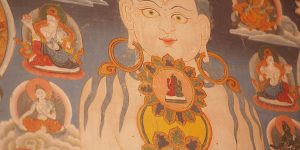An Introduction to Mantra: Great River of Compassion — by Jason Espada
Avalokiteshvara, help me to say this rightly, for all who could benefit from it.
By Jason Espada
From “Writing, music, and spoken word by Jason Espada”
For other wonderful features on Buddha Weekly by Jason Espada, see>>
Mantra [definition]
I: A set of sacred syllables, repeated to attain a spiritual benefit…
II. From the Sanskrit: A tool for thinking. 1. Prescribed syllables, in Sanskrit, to protect the mind from defilements. They express the essence of specific energies. The recitation of mantras is sometimes done with specific visualizations. 2. Often, Mantra is used as a synonym for Vajra, or Tantra, as in ‘Mantrayana’ – the path of mantra.

In thinking about writing this introduction, I’ve tried to bring to mind the most commonly asked questions about mantra practices. I know, first off, that most people have no interest in this subject, feeling completely sure, for some reason, that these practices don’t work, and that it’s a meaningless subject for them to learn anything about.
A second, much smaller group tend in the opposite direction – without trying things, they believe what they hear. They take it on faith, or because it sounds reasonable, or because it fits with their world view of what’s possible.
Both of these extremes, of tending toward credulity, or a pre-judged disbelief, would have to be set aside, before anything new can be learned, especially when it comes to more recondite subjects – where there is a lot that is hidden, or subtle – outside the range of our usual perceptions.
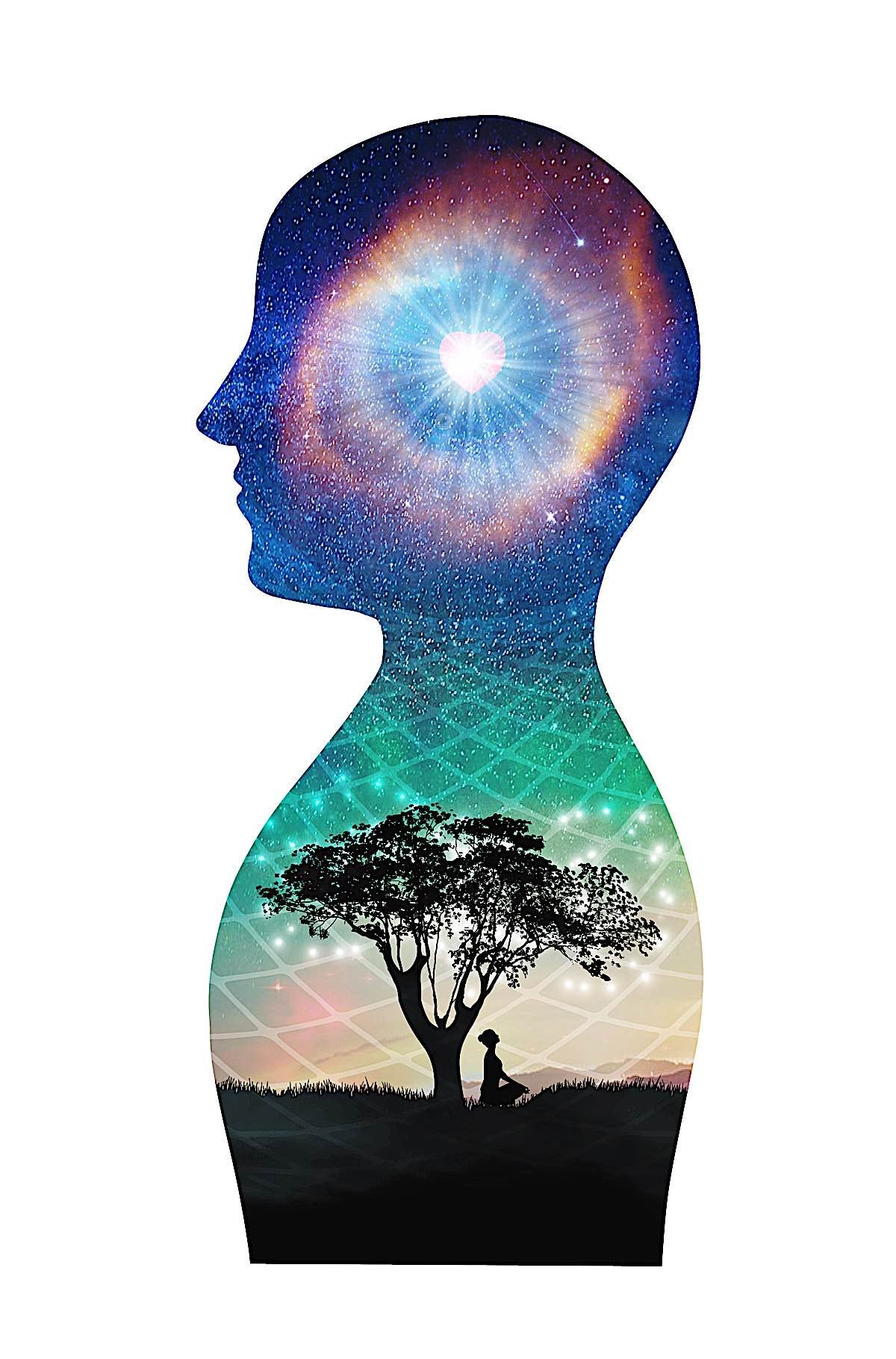
Instead of believing or not believing from the outset, perhaps someone new to this subject could listen to these ideas more as an invitation, to try some of these practices, or to see things in a different way.
I hope in these pages to be able to share some basic information, and to offer as much as I can in the way of warm encouragement to practice. The effects can really be great, profound and life-altering. They can change what we think of as ourselves, and what we think of as ‘a human being’.
As Rumi said,
Human beings are mines…
We have all these richnesses inside us. All these potentials. May they manifest effortlessly in whatever way, and as much as necessary for the benefit of living beings.
Imagine if someone told you that you had a pot of gold right around the corner from where you are standing, in your very own backyard. Whether or not you knew this person, it would at least be worth a look. If they even said that you had a single gold coin, most of us would at least look. The usefulness of money is something we can all relate to – ‘no harm in trying’, we’d say. And yet, compared to the claims that are made about the power of mantra, the usefulness of money is limited, almost nothing. There are other kinds of wealth near at hand that we can have access to and make use of.

Our body contains medicine
When we’re first introduced to the idea that there are healing properties within our body and mind, that can be contacted and increased, we might be surprised. After all, it goes against everything we’ve been taught about who we are – and these beliefs can be quite solid.
If someone says to you that your body contains healing properties that can be awakened and increased, it’s like being told that there’s gold nearby, in your own yard. First, you’d want to know where, and second, how much! Well, the teachings on mantra provide the ‘where’ – the directions, if you will, to inner treasures.
As far as the ‘how much’, I’ll repeat what tradition teaches, and that is, that it depends on the person and the practice itself what will come about. As always, there is the invitation to practice, to experience and see for yourself, along with the encouragement that these practices could be of great benefit to yourself and others.
If you find you are interested, then please do give these practices a fair try, in terms of time and effort, as it’s said, to awaken the energy of the mantra.

Working from two directions
Let’s say you want to cultivate compassion. You may choose to recite the compassion mantra, OM MANI PEME HUM. An experience like this may follow: you can feel peaceful, and have a warm feeling. You may see light like sunlight, rising from within. You may want to share that feeling or express that feeling in some way…
While reciting, you may pause, and say, “may all beings be happy”, “may all beings be peaceful…”, or make prayers of that nature.
The feeling then can be somewhat different – as if you are using a different part of the mind to cultivate good-will, love and compassion.
Reciting the mantra, you can have the feeling arising from within, surfacing, as it were, from the depths. And then, praying, or thinking May all beings be happy, from a contemplative level of mind, deeper than ordinary thinking, you may feel this same feeling is both being cultivated or awakened by your prayer, and also changing your surface thought and feeling.
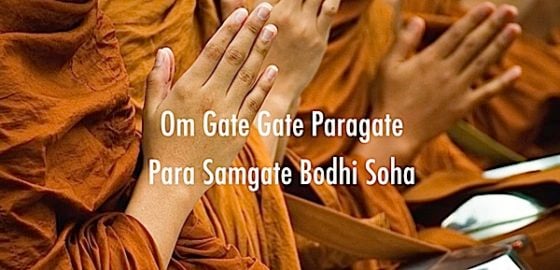
Two explanations for why mantra works at a deeper level
It’s taught in both the Indian and Tibetan traditions that the sounds of the syllables of mantra themselves have power. They embody, or express, or are the quality that we aim to produce, experience, or cultivate. The sounds are themselves the quality we aim to experience, and to make use of to benefit self and others. This is one explanation.
The other explanation is that, through use over generations, mantras have been associated with qualities, or states of consciousness. And when we repeat the syllables of a mantra, we tap into a reservoir of particular life-energy, or power that has been built up over time.
Either way, if it works, that itself is proof enough. We really don’t need a theory, though it may clarify some of what goes on. Personally, I feel there is truth in both explanations as to why mantra works.
Often when we read about the use of prayer or mantra, we read extraordinary statements – far from our usual world view. And I must say, in all honesty, that there is something in mantra that is beyond description, and that needs to be mentioned.
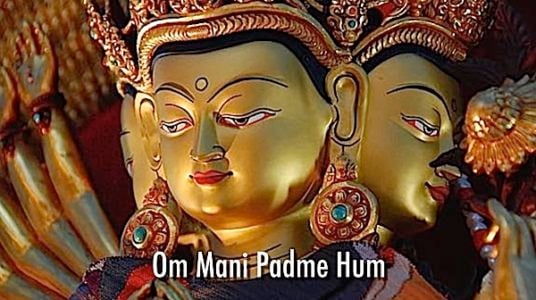
More food for thought – On world view
I recall reading early books about Tibetan Buddhism, the branch of Buddhism where mantra has flourished. They referred to the Tibetan Tradition as “Magical Buddhism”, and in a way they were right. The starting point for much of the prayer, visualization and mantra in the Tibetan Tradition is what can be called a magical world view.
A magical world view, wherever it is found:
- asserts levels of reality beyond the physical world, and that there can be interaction between the different levels;
- In a magical world view, thought, or more particularly focused thought, is considered a creative force, a world changing force, to a much greater extent than is commonly believed.
- Often in a magical world view, spirits of different types can be called on for assistance in various matters, and they will come – ancestors, saints, forms of divine beings, such as angels or bodhisattvas, or saviors;
Sometimes in a magical world view, the whole world is thought to be alive, sentient.
Magic, in its most general sense, is changing the outside world by changing something in the inside world. This is often accomplished by ritual, or by prayer, meditation, the use of mantra, or a combination of these.
Sometimes it’s asked, with so many mantras, where should a person begin? I think of one analogy I heard years ago, that points to an answer, and that at the same time offers an explanation of why one mantra may be more suitable for a person, and another not work for them. It goes like this:
Imagine a field or a plot of land, and beneath the surface of the earth, at different depths, are different kinds of seeds. The seeds that are closest to the surface are those that will give results first, or the most quickly. This is why gurus, or teachers with insight into a student’s nature, their ‘field’, so to speak, are traditionally the ones who tell the student what mantra to practice.
The theory of karma – past experiences determining one’s character and affinities – can be useful for some people, but it’s not essential to accept as a prerequisite for practice. Just do some practice and you will see for yourself what mantra brings you what, if any results.

The quantitative and qualitative aspects of mantra practice
When we make contact with a tradition through study, recitation, chanting or mantra, we can feel that we connect with a flow of energy to some extent. It may be a subtle feeling, or it can be something stronger, like a steady current. Sometimes it can be quite a forceful experience of energy, of a certain type of life that we are in touch with.
It can be like opening the sluice of a canal. We can feel we have contacted some source of energy, and we can feel it moving in us or through us. (See ‘Imagine an underwater system of channels…’ – the short poem that follows this essay)
However, if we only talk about a quantitative increase in energy, as if life-energy were just a generic force, like water or electricity, that would not be saying enough. It wouldn’t fully describe what we meet with and utilize when we connect with a tradition or make use of a mantra. We also need to speak of the qualitative aspect of spirit.
Ajaan Lee said this about the worth, or the value and power of certain states:
Things that are genuine, or pure, even though they may be small, can give rise to enormous results. Just as a piece of genuine paper money – a tiny strip of paper with the state seal – can be put to use in all sorts of ways. But if it’s newsprint, even a bushel of it wouldn’t be able to buy a thing. In the same way, a pure mind, even if we can make it pure for only a little while, can give rise to results way in excess of its size.
And, in speaking about specific qualities, here’s how one teacher named Mingyur Rinpoche replied when asked,
What does blessing mean?
He said,
It is a particular type of power… various medicines have various types of strength, or power. Water has a power to wet things and clean things. Fire has a power to burn. When we put water in a field, it helps to grow flowers or crops. All phenomena have a particular power associated with them… Blessing comes as a particular type of power.
(to accomplish a specific purpose).
For example, when one prays, “Grant me your blessing that uncontrived devotion may arise in me”, What happens is, that one receives that power, the blessing, and one’s defilements and obscurations are purified and dispelled. If one gives rise to devotion and faith and supplicates, then one has the blessing connected with arising of faith and devotion.
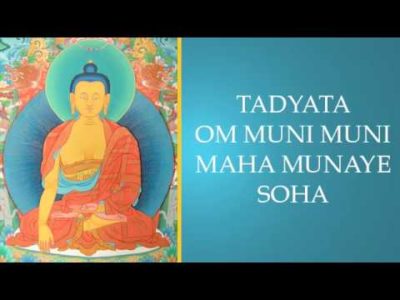
Many different practices
There are many different mantras, and many different practices that one can choose. Sometimes these are called ‘yidam‘ or ‘deity’ practices. It think it’s important to consider clearly here what is meant by the word ‘deity’ in Buddhism. This is a difficult word for Westerners. We have a 2000 year monotheistic tradition that is in our Western soul, and any term that brings to mind our Western Tradition needs to be considered carefully.
All of the qualities represented by figures in Buddhism are within each of us. Every quality, of love, intelligence, purity, healing power – but usually we don’t see ourselves this way. If our self view were to fluctuate, even a little, we would find that simultaneously the way we view images representing enlightened qualities would change too.
If we see ourselves as ordinary beings, and we experience ourselves as fundamentally without these qualities, then naturally if we think of Buddha’s or Bodhisattva’s qualities existing at all, they are felt to exist outside of us. (more on that in a moment, but first, a little more on this line of thought)
If there is a change in our self-view, or the way we experience our self-nature, then when we look at these images we can feel that “this quality is there – it is in Tradition and it is in me, as potential perhaps, but in the same way the fully developed flower-and-fruit giving tree is in the seed and the first shoots”.
In addition to there being an external, historical aspect, like a reservoir of a particular energy that can be contacted, we can also feel that the image or the idea of what is called ‘a deity’ represents aspects of our own nature, fully developed.
Perhaps when we are there, when we are the fully expression of some enlightened quality, then we could look at the image, sometimes called ‘deity’, and, with understanding, say “That is me”.
There may be one place where the Western idea of a deity and the way it is made use of in the Vajrayana overlap, and that is in its external aspect. Names and forms of Buddhas and bodhisattvas can be called on, and they will respond. Not for everyone, and not always, but this is an inherited truth, this has been many peoples experience in many places throughout time. I’ve had this experience myself on many occasions or else I probably wouldn’t be writing this.
Actually, many people have had the experience that mantra and prayer really do work in the ways they are praised – to heal, to harmonize, to clarify, but, again, as we say ‘the proof is in the pudding’; i.e., they are self-revealing, we have to know them for ourselves.
My feeling is that if others, or if even one other person could hear about these things, be inspired to practice, and gain some of this benefit, then my efforts here will have met with success. So I know I at least have to try to speak of these things.
To call on a holy Name, and to feel some response, this is precious, of inconceivable worth, but there is more intended by the practice of mantra and the forms passed down to us to be meditated upon. We can receive their benefit as needed in our lives. And we are also encouraged to cultivate this understanding, that we all have all these qualities within us. We are encouraged to bring them out as much as we can, and to live and act in this world, in enlightened and enlightening ways, with compassion and wisdom.
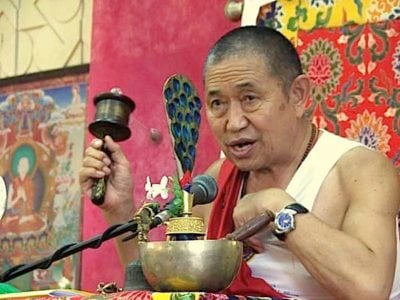
Mahayana
What’s called ‘Mahayana’ in Buddhist traditions refers to a re-orientation towards teachings, self, and others in the world. All Buddhist lineages have teachings about love and compassion, but in Mahayana this aspect is placed right in the center. In this way of thought, the needs of all others, inclusively, and compassion for all is emphasized, and then every other practice, such as calm meditation, contemplation on mortality, karma or realizing selflessness, is seen in relation the suffering and confusion of living beings.
All these teachings then take on vast importance. When practiced, they can help us first to help ourselves, freeing, awakening, and increasing our ability to help, and they can directly help others. When held, and maintained, all these teachings and practices can be seen as being not just for ourselves, and then their potential, to bring happiness and to remove suffering, can be perceived to be as it is – as something enormous, limitless. Seen this way, our appreciation of the value of these teachings can increase enormously in our mind.
These teachings and practices have the potential to benefit self and others. They can open the way to peace, health and every enjoyment, so their value is naturally very great.
What then to say about mantra? In this context, a Mahayanist, whether they think of themselves as Buddhist or not, someone who has bodhicitta heart, the intention to remove as much suffering as possible and to benefit others as much as possible, naturally will look in an unprejudiced way for whatever can help. Naturally, there will be no obstacle to that kind of determination to help. What joy, then, when someone with these pure, good intentions, finds the study and practice of mantra. Even if this is not for everyone, due to karma and people’s affinities, still, who would not be intrigued?
In the true Buddhist spirit of free inquiry, the way is open, and the warmest invitation is given, to try the practice for oneself, to see if they work as described in many places, or possibly too in ways that are even better. Of course, they may not work at all, but for those with an affinity with any of these practices, the results for oneself and for others can be very great.
On Mantra and Initiation
Often before beginning the practice of a mantra, a person will attend a ceremony called an initiation. This is helpful, to introduce a practice, and to further realization, but it is not essential to begin or to receive the benefits of a practice. If you begin some practice, and get some positive result, then you may like to consider attending an initiation. This can strengthen your practice, and facilitate realization. An experienced Lama can share his or her energy, and connect us to a living lineage of practice, and this can be something really profound.
Some people gladly travel great distances to attend initiations, because of how important they feel these events to be. If you have any interest, and the chance to attend an initiation, by all means do take the opportunity. You can check with your local Tibetan Buddhist centers for a schedule of events and initiations, which are also called empowerments. Usually there will be some teachings or commentary along with the ceremony that will explain what will take place and how to practice in detail. Until that time, however, mantras and practices are available.
It’s traditionally taught that what’s called ‘self-generation’ – where one visualizes oneself as the deity – should only be done by those who have received the initiation of a particular deity, but that ‘front generation’ – where one visualizes the deity in space above and in front of oneself – can be done by anyone.
In front generation, we visualize, or see with the mind’s eye above us, the Buddha or bodhisattva whose practice we are doing, and whose mantra we are reciting. It’s helpful when doing this recitation and visualization, to see pure light and nectar streaming from the image we hold, and that is also made entirely of pure light. These represent, or carry the blessings of the Buddha.
We should also see ourselves, our own body, not in an ordinary way, not as flesh and bone, but as also being made entirely of light. Many teachers advise, too, that when doing this visualization, we see ourselves in a pure land, and make the visualization as beautiful, peaceful, perfect, and pure as we can. This is helpful.
We can also do the practice without any elaborate or detailed visualization. We can just see light above us while reciting. Or without any visualization at all, we can just recite the mantra.
People ask, ‘But isn’t this all just the imagination?’, and the answer is… yes, and… no. It may begin that way, but sometimes something else, something quite wonderful, can enter into the practice. When done properly, by someone with an affinity for a particular practice, we can receive benefits far more than we could ever have merely imagined. We can tap into something larger than what we usually think of as ourselves, and receive fresh energy and inspiration. We can receive and awaken these different qualities that then can be made use of to benefit self and others.
May all beings be free from suffering and the causes of suffering
and may I be the cause of thisMay I contribute to their freedom from suffering
as much as I can
And,
May all beings have happiness and the causes of happiness
and may I be the cause of thisMay I contribute to their happiness
as much as I canMay everyone receive, understand and practice well the teachings that will benefit them the most, freeing their minds from suffering and confusion, and may all arrive at peace, fulfillment and joy in this very life.
* * *
Imagine an underwater system of channels
one channel opens
and the stream of cool, pure water can be felt moving through
felt all the way back to its source
Contacting a spiritual tradition can be this way
the clean, clear life moving through
felt in this very place, and known to its origin
Teachers, practitioners, deities, protector spirits
virtues faithfully maintained
and given forward through lives
We are welcomed by this, our family
They are eager to assist the awakening life
the heart becomes very quiet watching this work
this far reaching, unceasing compassion
They speak behind their words
move behind the curtains of form
in silence, shaping
All of this is given to you, it is immanent
the life within the life
More articles by this author
Search
Latest Features
Please support the "Spread the Dharma" mission as one of our heroic Dharma Supporting Members, or with a one-time donation.
Please Help Support the “Spread the Dharma” Mission!

Be a part of the noble mission as a supporting member or a patron, or a volunteer contributor of content.
The power of Dharma to help sentient beings, in part, lies in ensuring access to Buddha’s precious Dharma — the mission of Buddha Weekly. We can’t do it without you!
A non-profit association since 2007, Buddha Weekly published many feature articles, videos, and, podcasts. Please consider supporting the mission to preserve and “Spread the Dharma." Your support as either a patron or a supporting member helps defray the high costs of producing quality Dharma content. Thank you! Learn more here, or become one of our super karma heroes on Patreon.
Jason Espada
Author | Buddha Weekly
Jason Espada is a writer and classical musician living in San Francisco; a steward of his father’s photography, and the founder of A Buddhist Library: http://www.abuddhistlibrary.com. Over the years, he’s made a number of recordings of Buddhist teachings. These days his focus is on the natural connection between spirituality and social action. His new website is at JasonEspada.com.






